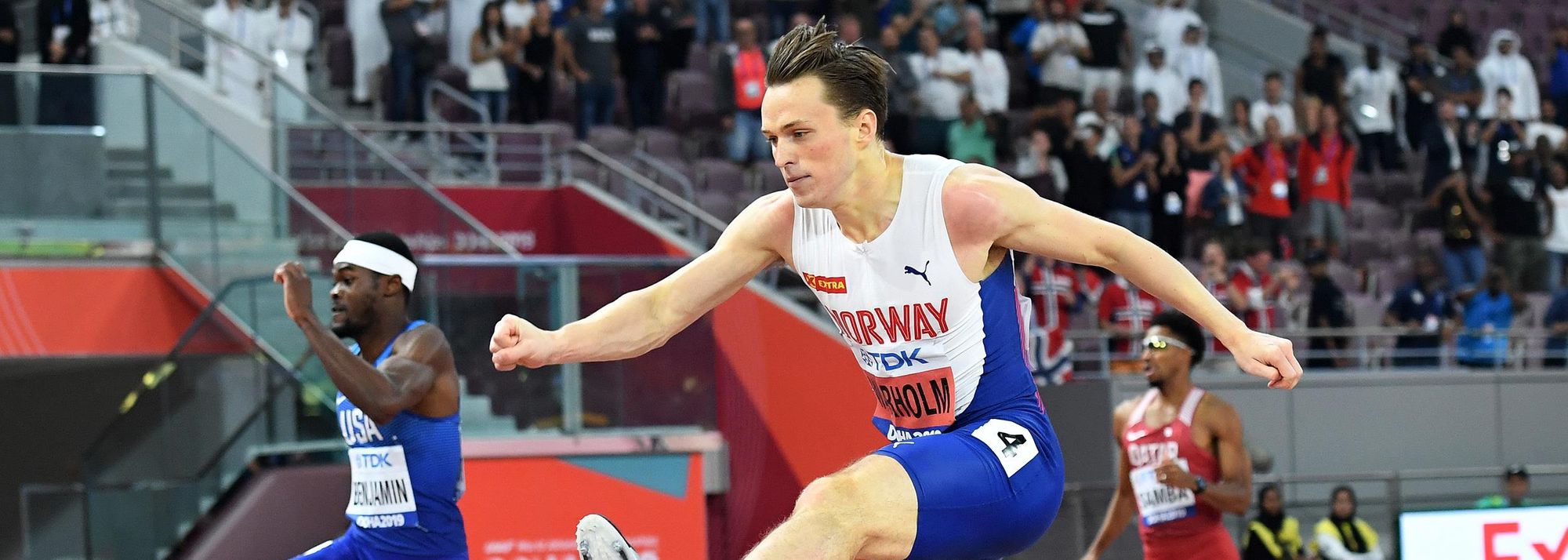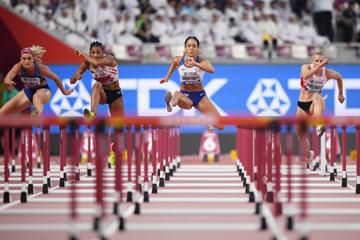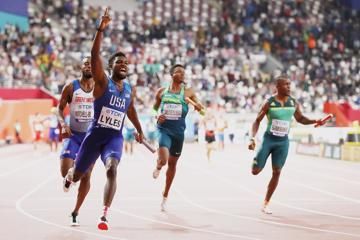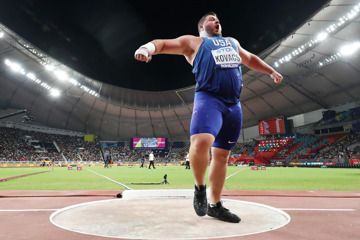Karsten Warholm on his way to winning the 400m hurdles at the IAAF World Athletics Championships Doha 2019 (© AFP / Getty Images)
Our end-of-year reviews continue with a look back at 2019’s top action in the hurdles events.
Men’s 110m hurdles
The World Championships may have signalled a changing of the guards in this event.
It’s possibly still too early to make a definitive call on that, but the way USA’s Grant Holloway handled himself in Doha was impressive. Despite being new on the international scene, the 21-year-old performed like a seasoned veteran, delivering three smooth runs in the Qatari capital where his victories never were in doubt.
His World Championships triumph came four months after the conclusion of a long and exhausting collegiate season, culminating in early June with winning the NCAA title in a world-leading 12.98 which made him one of the youngest sub-13 runners in history. His 2019 campaign had started back in January and he had a break of just 20 days between his indoor and outdoor seasons.
Behind Holloway in the World Championships final, some of the event’s most experienced exponents battled for the other medals. Olympic champion Omar McLeod looked well on his way to the silver when he started to hit some hurdles, tumbling into the next lane and blocking the fast-finishing Diamond League winner Orlando Ortega. This in turn opened the way for 2015 world champion Sergey Shubenkov to take silver.
McLeod was disqualified and, after long deliberations, the jury of appeal made the unique decision to award a bronze medal not only to third-place finisher Pacal Martinot-Lagarde but also to the impeded Ortega, who had crossed the line in fifth place.
For much of the first half of the year, Holloway was frequently pushed by Daniel Roberts, six months Holloway’s junior. In their five outdoor encounters before Doha, Roberts actually had the upper hand: 3-2. Their sixth match-up – in Doha – unfortunately never materialised as Roberts was disqualified in his heat for inadvertently knocking down a hurdle in an adjacent lane.
Women’s 100m hurdles
It was an exciting season in the women’s hurdles with different athletes excelling at different points of the season.
It became apparent that the 2017 world title would not be retained in Doha, as Australia’s Sally Pearson announced her retirement in August, having had six injuries during 2019. The 33-year-old, who won the 2011 and 2017 world titles as well as the 2012 Olympic gold medal, had been in good form earlier in the season, clocking 12.70 in Osaka in May.
The fastest athlete of the early season was 21-year-old Janeek Brown. She clocked 12.40 to equal the Jamaican record when winning at the NCAA Championships in June. She was not in the same form in Europe later, but fellow Jamaican Danielle Williams took over the mantle. The 27-year-old set a 12.32 national record when winning at the Diamond League meeting in London in July and was convincing in the World Championships heats and semifinals, easily making it to the final.
World record-holder Kendra Harrison was also in promising form, clocking a 12.43 season’s best to win in Monaco in July and then winning the US Championships later that month in 12.44 into a headwind. She, too, won her heat and semifinal in Doha.
There was a slight surprise in the final, though, as Nia Ali emerged as the winner in a 12.34 personal best. The 31-year-old US sprint hurdler, who had won world indoor 60m hurdles titles in 2014 and 2016, had only run 12.55 before Doha, but she clocked a 12.44 personal best in the semifinals and then crowned her career with a great run in the final.
Men’s 400m hurdles
The brilliant performances from Abderrahman Samba, Karsten Warholm and Rai Benjamin last year led to great expectations for 2019.
Even though the number of head-to-head encounters between the trio remained small – mainly because Samba sustained a hip injury mid-season – 2019 did indeed become a year for the history books.
This was, to a large extent, thanks to the undefeated Warholm who competed seven times between late May and early October, running sub-47.50 on all occasions but one (his season opener on a cold evening at the Stockholm Diamond League where he ran 47.85).
Warholm’s seasonal record proved to be the best ever in the event. Of the 17 sub-47.50 runners of all time, only four have done it more than four times – in their whole careers, let alone in one season. Even legends such as Edwin Moses and Kevin Young never had more than three in one season.
The all-time list of top-five seasonal average is as follows:
1 Warholm 47.210 (2019)
2 Benjamin 47.322 (2019)
3 Samba 47.332 (2018)
4 Young 47.366 (1992)
5 Moses 47.402 (1981)
This also underlines how exceptional the current leading trio is; in the past two years, they have produced the three best seasons in the history of the 400m hurdles. It’s also worth noting that Young and Moses reached their peak at the age of 26, while Warholm (23), Benjamin (22) and Samba (24) are a few years younger.
There are younger talents emerging, too. Brazilian teenager Alison Dos Santos is on a steep upward trajectory; after earning bronze at the World U20 Championships last year in 49.78, he chipped away at his PB throughout 2019 and produced a 48.29 clocking to finish seventh in the World Championships final.
Women’s 400m hurdles
It was clear from early in the season that the 2019 campaign in the women’s 400m hurdles would be a duel between two US athletes.
Twenty-year-old Sydney McLaughlin had run 52.75 as an U20 athlete last year, while Olympic champion Dalilah Muhammad started well following a solid but unspectacular 2018 season.
McLaughlin came out on top in their first head-to-head battle of the year, winning in Oslo in 54.16 to Muhammad’s 54.35. But the real bomb was dropped at the US Championships where Muhammad broke Yuliya Pechonkina’s world record of 52.34, which had stood for almost 16 years. Muhammad clocked 52.20 with McLaughlin running 52.88 for second place.
The tables were turned in Zürich in late August, however, when McLaughlin won the Diamond League final in dominant fashion in a season’s best of 52.85 with Muhammad way back in third place in 54.13.
But while McLaughlin appeared to be timing her peak well, Muhammad was by no means finished. Pushed all the way by her younger teammate, Muhammad held on for victory in the World Championships final, setting her second world record of the season with 52.16. McLaughlin closed the gap in the final stages to finish just 0.07 behind Muhammad in 52.23, becoming the second-fastest athlete ever.
Muhammad may have ended the season at the top of the world lists, but McLaughlin made a bit of history by becoming the first woman in history to produce three sub-53-second performances in one season.
As they had been for most of the season, the other World Championships finalists finished well behind the US duo in Doha. Jamaica’s Rushell Clayton had not broken 55 seconds before this season, but made good progress throughout year and took bronze in 53.74 in Doha, while Lea Sprunger set a Swiss record of 54.16 for fourth place.
Aside from McLaughlin, the only other athlete to defeat Muhammad this year was Shamier Little, but a fourth-place finish at the competitive US Championships meant the 2015 world silver medallist didn’t make the team for Doha.
Mirko Jalava (women’s events) and A Lennart Julin (men’s events) for World Athletics








